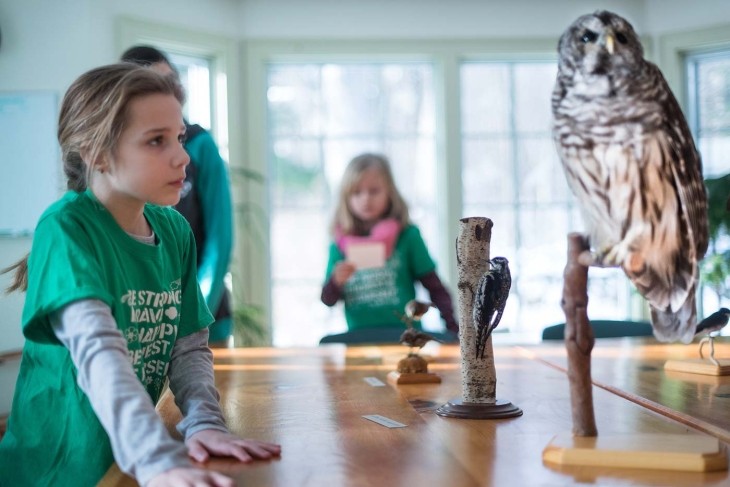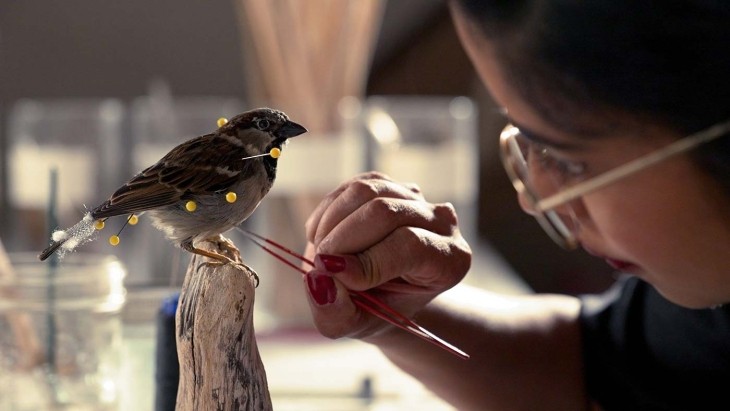
As a child growing up in Miami, Divya Anantharaman didn’t have much exposure to wild animals. Then, her family visited an African mammal diorama at a local natural history museum, and her world changed. “It was the first time I saw a lion in person, and I was blown away,” she recalls. “I’d seen them on TV and in drawings, but seeing how huge it was in real life amazed me. It wasn’t a cartoon or The Lion King. It was a real animal, and it had a paw the size of my face.”
Nearly three decades later, Anantharaman is still enthralled by animals, and by taxidermy’s power to connect us to the wild. An award-winning taxidermist based in New York City, she specializes in birds and small mammals, and assists with restoration of historic museum specimens.
Taxidermy – the scientific art of preparing, preserving, and mounting the skins of dead animals on forms – has a complicated history, with roots in overharvesting and exploitation. In her work, Anantharaman acknowledges the complexities of the past. “When you read the works of 19th-century naturalists, they thought killing and preserving these animals would ultimately help save these species,” she says. Before photography was readily available, taxidermy offered proof of existence, as well as a rare opportunity to study an animal’s body in great detail. The birds Darwin collected and preserved during his voyage on the HMS Beagle, for instance, were instrumental in shaping his understanding of evolution.
Today, samples from historic specimens are used in taxonomic, genetic, and even epidemiological studies, and mounts of now-extinct species such as the passenger pigeon or Carolina parakeet offer a uniquely haunting message about the importance of conservation.
“If it weren’t for these practices, we wouldn’t have the scientific knowledge we have now,” Anantharaman says. “But that knowledge has come at a cost.”
Since the 1800s, the culture and practice of taxidermy have changed. Modern taxidermy is bound by laws that protect wildlife, such as the Convention on International Trades in Endangered Species of Wild Fauna and Flora (CITES), the Endangered Species Act, and the Migratory Bird Treaty Act.
In many cases, state and federal permits are required to both create and possess taxidermy, and some species are off-limits altogether. In addition, a growing number of taxidermists practice ethical, sustainable sourcing: that is, only using animals that died from natural or unrelated causes, such as illness, old age, vehicle collisions, or building strikes.
“There’s no part of this that comes from a place of disrespect,” Anantharaman says. “It comes from a place of honoring and appreciating these animals, and of wanting to share that appreciation.”
While many people are first introduced to taxidermy in museums, it has also long been a staple of environmental education. Some organizations, including the Harris Center for Conservation Education in Hancock, New Hampshire – where I work – opt not to display their collections at all, but to use them solely as teaching tools.
“When they’re displayed without context or discussion, they can become something to gawk at,” says Susie Spikol, naturalist and community programs director at the Harris Center. “They’re encased in glass, and we’re on the other side.”
When brought into a classroom, however, taxidermy can create an intimate connection. Harris Center naturalists most often use mounted specimens in lessons on wildlife adaptations, where children can examine how the structure of an animal’s body reflects its behavior and habitat. Taxidermy also allows students to look closely, in three dimensions – something that’s impossible to replicate through photos, videos, or even observing live animals.
“It offers stillness, too,” says Anantharaman. “At a zoo, you see an animal from a safe distance, and you can get a lot of really valuable information about how it eats or moves. But in the stillness of taxidermy, you have as much time as you want with that animal, and you can obsess over detail – a membrane on an eyelid, or the color of a bird’s feet. The birds I tend to work with are tiny. In the wild, I see them as a blur in my binoculars, but taxidermy gives you a really good look at the composition of their feathers.”
Most of the time, Spikol says, students have a compassionate response to the specimens she shares with them. The most common question she hears from elementary school students is, “Is it alive?” followed by, “How did it die?” and “Is it real?”
At a time when our lives seem to grow more virtual with every passing day, this “realness” makes an impact. “To be six inches away from a bobcat who once walked the earth,” marvels Spikol, “is irreplaceable.”


